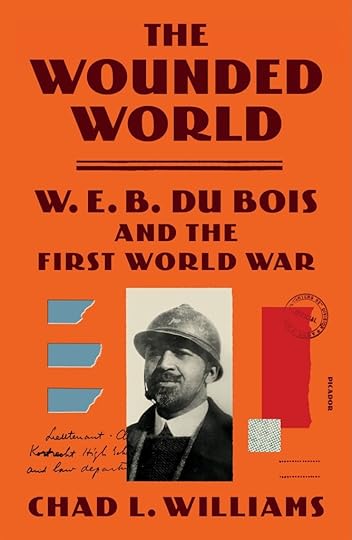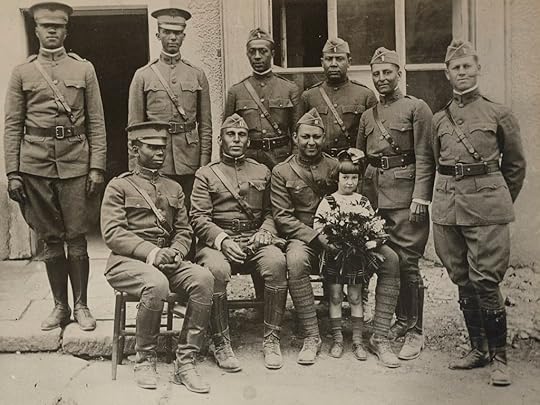Review: The Wounded world – W.E.B Du Bois & The First World War by Chad L. Williams

The Wounded World: W.E.B. Du Bois and The First World War by Chad L. Williams is a tome of invaluable knowledge concerning America’s race relations before, during, and after WWI. Williams’ book focuses on the saga of Du Bois’ life work in creating The Black Man and the Wounded Wolrd, an account of the experiences of black soldiers in WWI, which would after many decades and 1,000 pages go unfinished to this day.
America’s Selective Service Act came into effect May 18, 1917 which subsequently saw the registration of 2 million black men. However, due to the pressures of white southerners, black draftees could at first only be in the labor force. The NAACP fought back against this and eventually won the right for black men to fight. But it wasn’t that simple. 1917 was marked by push back against black men fighting in the military, the most contentious point being that white soldiers did not want to be commanded by black officers. On the home front, a race riot broke out in St. Louis in response to the influx of black workers to the city seeking war time factory jobs. The disturbing violence lasted 2 days, resulting in many dead and 7,000 residents displaced. Du Bois visited the wreckage days later and argued that the racist mob was far more violent and malicious than the Germans’ actions in WWI. In August, another racist mob attack occurred in Houston in response to an all black infantry training camp at Camp Logan.
In Europe, black soldiers were segregated from white soldiers and (despite the actions of the NAACP) largely assigned to service and labor work. There was one all black combat unit, but it was commanded by white officers. White officers used any excuse, overwhelmingly fabricated, to punish and humiliate the black soldiers. They were often arrested for “inefficiency,” accused of military failings, harassed by military police, arrested for alleged indiscretions, blamed for white officers’ mistakes, treated as prisoners, denied promotions, and the biggest and most pervasive accusation was that of rapes against Frenchwoman. The old racist trope of black men raping white women was well known in America at this time, and heavily influenced by the racist film Birth of a Nation and the go-to fabricated “excuse” for southern lynch mobs. This racist fabrication was so pervasive in France that the 92nd Division issued a general order in Dec 1918 restricting black soldiers from interacting with the French people, especially the women. In reality, white officers did not want the black soldiers to speak or interact with the French because the French people actually treated them with sympathy, kindness, and a measure of social equality that these men did not have in the US. In turn, the white power structure believed the black soldiers not only needed to be “taken down a peg,” but also wanted to prevent the black soldiers from, at all costs, bringing home any “ideas” of equality from France. As the author argues, all these components put “America’s racism on display for the world.”

When Du Bois tried to report on these soldiers’ accounts of racism and fabricated accusations/crimes in his publication, The Crisis, the Postmaster General actually tried to suppress its distribution. In response to the issue’s publication, Du Bois received countless letters and photos from black servicemen which would eventually inspire and lead him to visit France in 1918 after the armistice to personally interview these men about their experiences. Of disillusioned soldiers returning home, Du Bois poignantly wrote, “We return. We return from fighting. We return fighting.”
The return of servicemen would spark what is now known as the “Red Summer of 1919,” in which several racist mob attacks and pogroms, filled with brutal and disturbing violence and lynchings, occurred across the nation. South Carolina, Arizona, Texas, and Washington DC all saw brutal attacks which led to a particularly brutal event in Chicago which left many dead, injured, and displaced. Red Summer inevitably bled into the Fall, with attacks in Knoxville and Omaha, Louisiana and Arkansas. In 1919 alone there were 76 lynching victims, 11 of which were returned servicemen. Amidst these nationwide racist attacks, President Woodrow Wilson did nothing and said nothing, which would inevitably set the stage for the notorious, brutally violent, and fatal 1921 Tulsa race massacre. The events of 1919 led many black activists and veterans to form their own organizations to fight for their rights, organizations of which were watched and under suspicion of Bolshevism by the American government. Du Bois himself had also been closely watched by the American government under the same suspicions when he went to France to interview soldiers.
Du Bois continued his work of documenting the black soldier experience in Europe, while at the same time black veterans were still facing racism and segregation at home despite the democracy they had served to protect overseas. Tuskegee essentially became the first black VA in 1923 in response to the little to no medical treatment of black veterans after the war. Veterans also began to grow impatient with Du Bois for still holding on to their letters, documents, and photos for his manuscript and by 1929 the manuscript had grown near 1,000 pages. Of the war and race, Du Bois wrote, “The world war was primarily the jealous and avaricious struggle for the largest share in exploiting darker races.”
Du Bois faced countless obstacles in seeking both funding and publishing due to the sheer volume and scope of The Black Man and the Wounded World. Competitive academic infighting amongst the community of black scholars and historians placed roadblocks in the path of writing and production. Over the years, Du Bois was also sidetracked by writing other books and historical studies. The author explains that decades on and beyond the second World War, Du Bois ultimately viewed The Black Man and the Wounded World as “too big, too disillusioning, too tragic…to reckon with the historical magnitude.” Williams’ study is a comprehensive and historically illuminating account and tribute to Du Bois’ massive, unpublished work–his life’s work.
What I found most striking about this work was its complete and utter relevance to today’s world. The events of 1918/1919 with the influenza pandemic and racial riots/attacks are nearly identical to our current period of the covid pandemic and race riots. I was astounded by how many writings and quoted sources of the time could have easily been from today and not 100 years ago.



